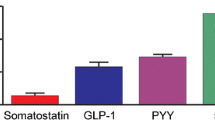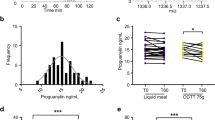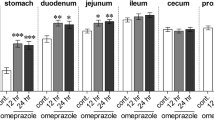Abstract
Massive secretory diarrhea is associated with some villous adenomas. The mechanism of this secretion is unknown but the character of the diarrhea resembles that of cyclic nucleotide-mediated diarrheas. We have compared the cyclic nucleotide metabolism of a large secretory villous adenoma with a nonsecretory villous adenoma, a solid, carcinoma and their normal mucosae. The adenylate cyclase, cyclic AMP content, and a cyclic AMP-dependent protein kinase ratios in the secretory tumor were increased as compared to these values in the nonsecretory tumors and normal mucosae, a situation similar to that seen with cholera toxin-induced diarrhea. Our data suggest that the massive diarrhea in our patient with a secretory villous adenoma may be related to increased adenylate cyclase activity.
Similar content being viewed by others
References
McKittrick LS, Wheelock FC Jr: Carcinoma of Colon. Springfield, Illinois, Charles C Thomas 1954, p 61
DaCruz GM, Gardner JD, Peskin GW: Mechanisms of diarrhea of villous adenomas. Am J Surg 115:208, 1968
Duthie DL, Atwell JD: The absorption of water, sodium and potassium in the large intestine with particular reference to the effects of villous papillomas. Gut 4:373–377, 1963
Shields R: Absorption and secretion of electrolytes and water by the human colon, with particular reference to benign adenoma and papilloma. Br J Surg 53:893–897, 1966
Steven K, Lang P, Bukhave K: Prostaglandin E2-mediated secretory diarrhea in villous adenoma of rectum: Effect of treatment with indomethacin. Gastroenterology 80:1562–1566, 1981
Levine SD, Kachadoria WA, Verna NC: Effect of hydrazine on transport in toad urinary bladders. Am J Physiol 239:F319–327, 1980
Bisordi JE, Schlondorff D, Hays RM: Interaction of vasopressin and prostaglandins in toad urinary bladders. J Clin Invest 66:1200–1210, 1980
Nimmo HG, Cohen P: Hormonal control of protein phosphorylation. Adv Cyclic Nucleotide Res 8:145–266, 1977
Stewler G, Orloff J: Role of cyclic nucleotides in the transport of water and electrolytes. Adv Cyclic Nucleotide Res 8:311–361, 1977
Cassel D, Schlinger Z: Mechanism of adenylate cyclase activation by cholera toxin: Inhibition of GTP hydrolysis at the regulatory site. Proc Natl Acad Sci USA 74:3307–3311, 1977
Author information
Authors and Affiliations
Additional information
This work was supported in part by NIH grant AM-22036 (Dr. Schlondorff).
Rights and permissions
About this article
Cite this article
Jacob, H., Schlondorff, D., Onge, G.S. et al. Villous adenoma depletion syndrome. Digest Dis Sci 30, 637–641 (1985). https://doi.org/10.1007/BF01308412
Received:
Revised:
Accepted:
Issue Date:
DOI: https://doi.org/10.1007/BF01308412




